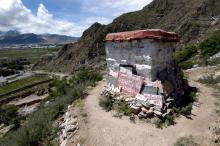Explore Sera Monastery

Located about two miles north of Lhasa, and occupying an area of about one-third of a square kilometer, Sera Monastery (Sera Gön) is one of the three great monasteries (drasa) or seats (densa) of the Geluk school of Tibetan Buddhism. According to tradition, Tsongkhapa (1357-1419), the founder of the Geluk school, composed his commentary on Nāgārjuna’s Mūlamadhyamakakārikā, entitled The Ocean of Reasoning (Rikpé Gyatso), in a small hermitage called Sera Chöding in the foothills just above Sera around the year 1409. In the midst of writing this work, one of the folios of the text flew into the air in a gust of wind. It began to emit “A” letters (the symbol of the perfection of wisdom) in the color of molten gold. Some of the letters dissolved into a stone at the base of the hill and permanently imprinted themselves on it.
Witnessing this, Tsongkhapa prophesied that this would be the future site of a great center of Buddhist learning, an institution of particular importance for the study and practice of the Madhyamaka doctrine of emptiness. A decade later, Jamchen Chöjé Shakya Yeshé (1354-1435), a close disciple of Tsongkhapa, founded Sera at this very site. Originally a monastery for the study and practice of tantra, some of Sera’s early preceptors steered the monastery in a more scholastic/philosophical direction shortly after its founding.
Excepted from an introductory essay for THL written by Prof. José Ignacio Cabézon
Owner
Shanti AdminAccessibility
Parent Collection
Members
* denotes that this member is inherited from a parent collection